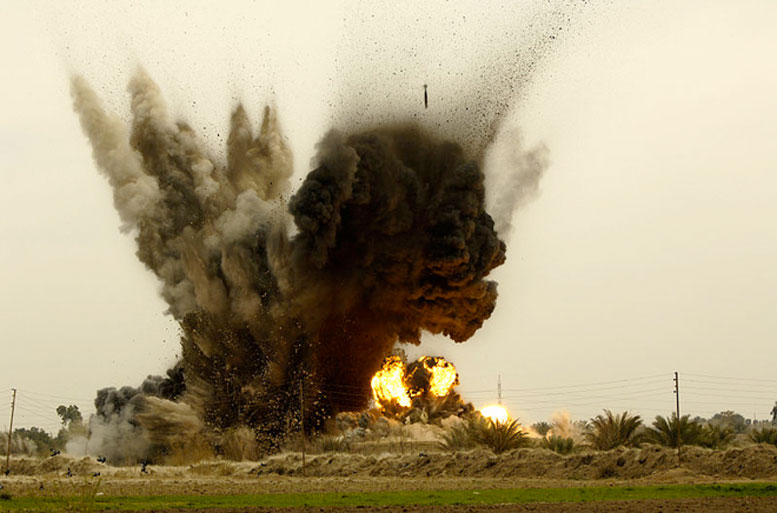From Precision Missiles to 2,000-lb Explosives,
Air Campaign Is One of the Heaviest in History
John Paul Rathbone / Financial Times
LONDON (December 6, 2023) — Benjamin Netanyahu, at least in private, has been blunt about what Israel needs most to destroy Hamas: a steady supply of more US bombs.
“We need three things from the US: munitions, munitions, and munitions,” the Israeli prime minister told a group of local government officials, according to a recording obtained by the Israel Hayom newspaper.
“There are huge demonstrations in western capitals,” added Netanyahu, who is concerned political pressure overseas might threaten the US arms shipments. “We need to apply counter-pressure . . . There have been disagreements with the best of our friends.”
Israel has expended vast amounts of ammunition in its war against Hamas in Gaza. The modern western weaponry used, from satellite-guided “bunker busting” bombs to pinpoint-accurate laser-guided missiles, have eroded Hamas’s military capabilities and, according to the Israel Defense Forces, killed more than 5,000 of the group’s estimated 30,000 fighters.
Aerial bombs used by Israel GICHD,
However, the damage wrought by Israel’s attack — triggered by Hamas’s assault on October 7 when it killed 1,200 people and took more than 200 hostages — has been catastrophic.
Citing estimates of damage to urban areas, military analysts say the destruction of northern Gaza in less than seven weeks has approached that caused by the years-long carpet-bombing of German cities during the second world war.
“Dresden, Hamburg, Cologne — some of the world’s heaviest-ever bombings are remembered by their place names,” said Robert Pape, a US military historian and author of Bombing to Win, a landmark survey of 20th century bombing campaigns. “Gaza will also go down as a place name denoting one of history’s heaviest conventional bombing campaigns.”
Whole neighbourhoods have been levelled. By December 4, more than 60 per cent of the buildings in north Gaza had been severely damaged, according to analysis of satellite radar data by Corey Scher of CUNY Graduate Center and Jamon Van Den Hoek of Oregon State University.
That rises to as much as 70 per cent of buildings in some districts. Across the whole of Gaza, between 82,600 and 105,300 buildings have been left in ruins, according to the estimate, which counts buildings where at least half the structure was damaged.
By contrast, over the space of two years, between 1943 and 1945, the Allied bombing of 61 major German cities razed an estimated 50 per cent of their urban areas, according to Pape. One US military review from 1954 estimated 7,100 tonnes of allied munitions were dropped on Dresden, severely damaging 56 per cent of non-industrial buildings, half of homes, and killing about 25,000.

Dresden, Germany in 1945.
One reason for the scale of destruction is the munitions that Israel uses. The IDF has not released public information, but images posted daily by the Israeli military show its jets taking off, loaded with ordinance that has been identified to the Financial Times by explosives experts.
Some of the munitions are pinpoint accurate, which can help limit collateral damage. Among them are precision-guided 250lb small-diameter bombs which, because of their relatively small size, “inherently reduces the probability of collateral damage”, according to the US Air Force.
Israeli attack helicopters have also carried laser-guided “Hellfire” missiles, a mainstay of US urban fighting against Isis militants in Iraq and Syria, and “fire and forget” Spike missiles, which are traditionally Israel’s weapon of choice for precise, targeted killings.
However, Israeli jets have also dropped unguided M117 “dumb bombs”, as first used by US forces during the Korean and Vietnam wars. In addition, Israel has used earth-shaking 2,000lb GBU-31 bombs, which are four times bigger than the 500lb bombs that were typically the largest ordinance used by allied forces in the battle for the Iraqi city of Mosul, military analysts said.
“Hamas’s October 7 attack was a laundry list of war crimes and it continues to produce daily evidence of further possible war crimes,” said Janina Dill, professor of global security at Oxford university’s Blavatnik School of Government. “Even so, it has been striking how often the Israeli army has reached for 2,000lb bombs.”
The force of these bombs, which are enhanced with a global positioning system that turns them into “smart bombs” or so-called Joint Direct Attack Munitions (JDAMs), is so immense that blast survivors have said they feel they are “surfing liquid earth”, said Marc Garlasco, a military adviser for Dutch organisation PAX and a former Pentagon intelligence analyst.
“Buildings pancake, their support disintegrates so they collapse in on themselves, and then there are the area effects — including the secondary fragmentation of cement, metal, peoples’ cell phones and everything else that flies out from the explosion at supersonic speeds,” he said.
“The only reason I can think of why they have been used is that the IDF has been trying to collapse Hamas’s tunnel network,” Garlasco added. “What is remarkable though is their widespread use.”
The campaign group Amnesty International this week called for a war crimes investigation over Israel’s use of such heavy munitions, claiming there was evidence indicating that 1,000lb and 2,000lb bombs were used in strikes on homes in Gaza that killed 43 people.
A second reason for the high level of destruction is the speed and intensity of Israel’s bombing campaign, military analysts said, as well as relaxed targeting rules which may have allowed for a greater number of expected civilian casualties.
In past conflicts, the Jewish state’s strikes underwent a vetting process whereby they were first cleared by IDF lawyers. While rarely a black and white process, “if they [the IDF lawyers] say something is not legal, you can’t do it”, said Pnina Sharvit Baruch, a former senior IDF legal adviser who now heads the law and national security programme at Israel’s Institute for National Security Studies.
Yet from the first moment after Hamas’s October 7 attack, Israel officials have said their response would be of a completely different magnitude to previous operations.
In just the first two weeks of its campaign, Israel used at least 1,000 air-to surface munitions daily, estimated John Ridge, an open-source intelligence analyst and munitions expert. By comparison, during the most intense periods of the US and coalition air campaign in Mosul, roughly 600 munitions were dropped a week.

Blast effects of Mk 82 bomb detonation.
As for its ground operations, the IDF has said it has shortened “kill chains” so that it takes less than 10 minutes for real-time intelligence to identify a target and then hit it with an air strike.
“The sheer pace of the campaign does raise questions about the Israeli rules of engagement, its targeting process, and the levels of civilian casualties it is prepared to accept,” said Jeremy Binnie, Middle East defence specialist at Janes, a defence and open-source intelligence firm in London.
Assaf Orion, the former head of IDF strategy, admitted as much last week when he said the Israeli military has “its own interests to decrease the damage to civilian population as collateral . . . but at the same time we cannot keep on being . . . overcautious . . . as we used to in the past”.
Israel has said, given the scale of the Hamas atrocities, it had no choice but to “eliminate” such a threat from recurring in future. Israeli officials acknowledge that pursuing this aim in a densely populated urban area, against heavily fortified militants fighting from within residential neighbourhoods, has put civilian lives at risk. IDF chief of staff Herzi Halevi on Tuesday said Israeli forces were having to operate “powerfully, while making big efforts to mitigate as much as possible harm to civilians”.
But the rising civilian death toll has also strained the support of Israel’s allies. US secretary of state Antony Blinken said last week he had warned Netanyahu “that the massive loss of civilian life and displacement of the scale we saw in northern Gaza [must] not be repeated in the south”. US defence secretary Lloyd Austin also said the Jewish state risked “strategic defeat” unless it protected Palestinian civilian lives in Gaza.
Israel’s military has responded by saying it will take a different approach in the south, using data to identify densely populated areas and calculate evacuation routes as well as sharing mapsindicating where people should flee.
More than 15,000 Gazans had died before Israel even began its southern offensive last week, according to Palestinian officials in the Hamas-controlled territory. Israel claims this includes up to 5,000 Hamas fighters. By comparison, 12,000 civilians were recorded as killed in the first nine months of the 2003 US invasion of Iraq.
“By any measure, Gaza is already a high civilian punishment campaign,” said military historian Pape. “It will go down in history as one of the heaviest ever undertaken with conventional weapons.”
Additional reporting by Mehul Srivastava and Neri Zilber in Tel Aviv and Chloe Cornish in Jerusalem
Posted in accordance with Title 17, Section 107, US Code, for noncommercial, educational purposes.
